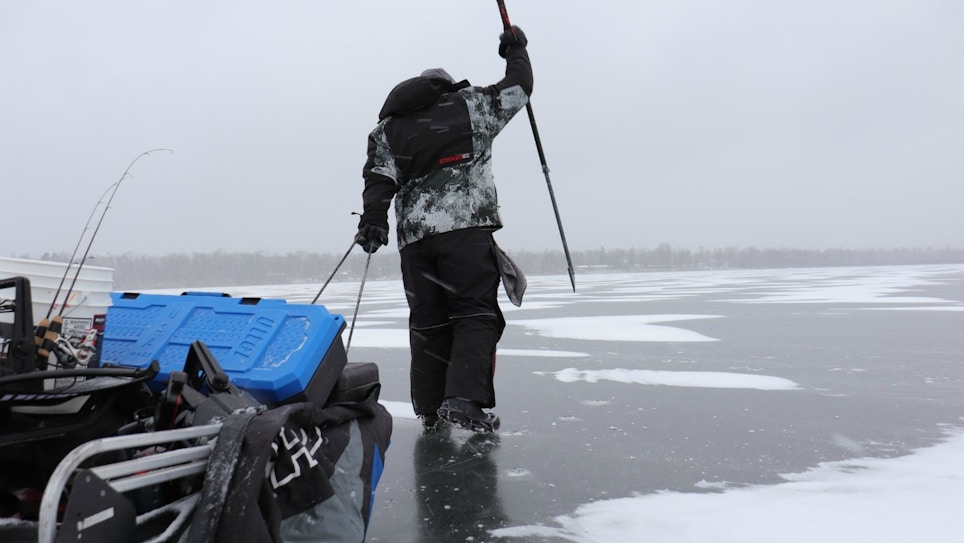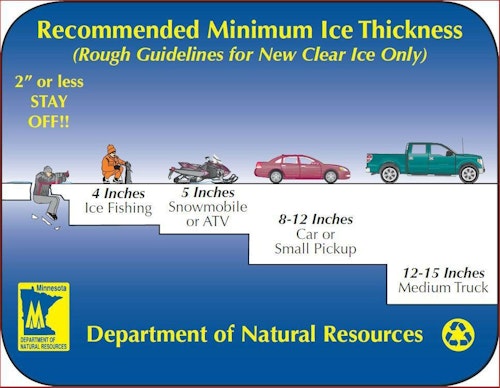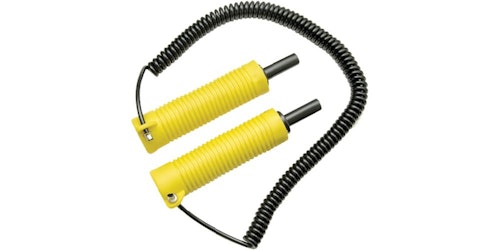You’ve probably heard the statement, “Ice is never safe.” The intent of this article isn’t to debate whether that’s true. I suppose you could say nearly the same about riding in a car, flying in a plane, or walking down the sidewalk on a summer’s day. Life is full of risk, and as someone who loves to fish and hunt, I must weigh risk/reward constantly in the field.
I’ve lived my entire life in Minnesota, and as someone who’s been ice fishing for 45 years, I’ve spent a lot of time on hard water. From ice fishing and snowmobiling to cross country skiing and ice skating, a frozen lake is a wonderful place for winter recreation, provided the ice is thick enough for your chosen activity.
The illustration below is from the Minnesota Department of Natural Resources, and it shows the recommended thickness of ice for traveling on foot, on ATVs and snowmobiles, and vehicles of various sizes. What is often not mentioned, however, is that the ice on any given body of water isn’t uniform. For example, the ice measure 4 inches throughout much of a lake during the early ice fishing season, but due to current, springs or other factors, it could suddenly change from 4 inches to 2 inches, or less. And that’s how people get into trouble.
The key to avoiding falling through the ice is knowing how to check its thickness as you travel on it. This is best done with the use of a spud bar (chisel). The video below does an excellent job of explaining, and showing, the process. Keep in mind that your results will likely be different than what is shown by the video host, Brett McComas. The weight and sharpness of your spud bar, as well as your strength, will change the results. But this is a good starting point. Watch it closely and learn.
I wear a parka specifically designed for ice fishing. It has built-in flotation, which would keep me from sinking and drowning. That said, I still would need to get out of the cold water to avoid hypothermia, so having ice picks handy makes it easier and faster to get back onto thicker ice. I use Frabill’s retractable ice picks.
Several companies offer ice fishing jackets with flotation technology; check out the Clam Ice Armor Rise Float Parka, Eskimo Roughneck Jacket, StrikerIce Hardwater Jacket, StrikeMaster Surface Jacket and others.

If you don’t own a flotation jacket designed for ice fishing, then wear a life jacket. Better safe than sorry is a good rule to follow when ice fishing.
The video below explains how to get out of the water should you fall through the ice. The event was performed under the supervision of a trained fire and EMS professionals. The host is wearing a life jacket, and the depth was 10 feet.
Be smart and stay safe this ice fishing season. Purchase a spud bar and learn how to use it. Invest in an ice fishing flotation suit, or at least wear a life jacket. Always wear ice picks. Of course, it’s always safest to ice fish with a friend, and it’s smart to carry an emergency throw rope. If you must go solo, then tell someone where you’re heading and when you expect to return.








